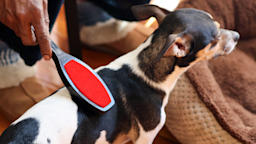Key takeaways:
Ticks can infect your dog with life-threatening diseases if they’re not removed properly.
You will need tweezers or a tick-removal tool to grasp the tick and pull it out completely.
Year-round tick prevention is the best way to keep ticks from feasting on your pet.
Ticks are pesky little blood suckers that transmit infectious diseases such as Rocky Mountain spotted fever and Lyme disease. They infect both humans and our furry friends.
There’s a proper way to remove a tick from your dog to lower their chances of infection. Here, you’ll learn the right way to remove a tick, when to see a veterinarian about a tick bite, and how to protect your pet year-round.
What’s the best way to remove a tick from your dog?
To remove a tick, you’ll need several tools to do the job right.
Search and compare options
Gather the following:
Pair of tweezers or tick-removal tool
Pet-safe antiseptic (such as chlorhexidine) for your dog’s tick bite wound
Gloves to keep your hands from coming into contact with the tick
Disinfectant for your gloves and tweezers
Then follow these steps:
1. Protect your hands
Put on a pair of latex or rubber gloves to keep your hands from direct contact with the tick and bacteria.
2. Calm your dog
Your pet may get a little stressed when you approach them with tweezers and gloves. Soothe them if they’re anxious.
3. Use tweezers or a tick remover
No matter which tool you use, grab the tick as close to your dog’s skin as possible. Pull straight up with a gentle but firm tugging motion. Try not to squish the tick. The fluids it carries could infect your animal.
Killing ticks quickly: Oral and topical medications can prevent and treat ticks on dogs. Read about your options.
Bravecto for dogs: This medication can prevent fleas and ticks from living on your dog’s skin. But is it right for your dog? This article answers your questions.
Can you use Neosporin on dogs? Yes, but only under a veterinarian’s supervision. Here’s what you need to know about this antibiotic ointment.
4. Save or photograph the tick
Your veterinarian may need to identify the tick if your dog gets sick. To save the tick, place it in a container with rubbing alcohol. You can also take a photo of the tick. Get rid of the tick by either flushing it down the toilet or freezing it in a plastic bag before throwing it in the trash.
5. Apply antiseptic
Disinfect the bite area on your dog with a pet-safe antiseptic.
6. Clean up
Throw away your gloves, disinfect your tweezers, and wash your hands.
Read more like this
Explore these related articles, suggested for readers like you.
Proper tick removal only takes a few minutes once you’ve gathered your tools. You may be tempted to use your fingers to get rid of it quickly, but that’s not a good idea. You can spread infection to your fingers, and you may not remove the tick entirely. Taking the time to do it right will be best for you and your pet.
What do ticks look like on dogs?
Ticks can look a couple of different ways on dogs, depending on whether the critter is searching for a spot to feed or actively feeding. A tick that’s roaming around your dog’s fur will look like a small, flat disc. A tick that’s feeding will look like a swollen lump.
Ticks come in shades of brown, gray, and black. Some may have a reddish coloring, too.
Adult ticks are about the size of an apple seed. Younger ticks are as tiny as a grain of sand or a poppy seed. You may want to grab a magnifying glass to look for ticks on your dog.
How to check your dog for ticks
Here’s how to look for ticks on your furry friend:
Run your fingers over your dog’s neck, back, haunches, and belly.
Look between their toes, in their ears, and on their face, including their eyelids.
Don’t forget to check their tail and under their collar.
If you see a small bump, look closely to see if it’s a tick. You may need a magnifying glass, as some ticks are only the size of a pinhead.
Ticks live in woods, forests, and backyards across the country. That’s why it’s important to check your dog for ticks whenever they spend time outdoors. Otherwise, you probably won’t know that your dog has a tick. Most dogs have no symptoms from an actual tick bite. They won’t usually scratch or chew the area.
What are the dangers of incorrectly removing ticks?
“When you remove the tick, the goal is to get the whole tick, including the head,” said Zachary Nesbit, DVM, of Godley Station Animal Hospital in Pooler, Georgia. “If the head is left behind, it can be a source of infection.”
Squeezing the tick so that it bursts can also spread infectious fluids.
Do not use petroleum jelly (Vaseline), nail polish remover, or heat to draw out the tick. You might have heard that these methods work. But they will not remove the tick properly and may prolong its life on your pet. The longer the critter is attached to your pup, the more time it has to infect them.
“The true danger of a tick bite is tick-borne disease. They can be debilitating and cause life-threatening illness,” Nesbit said. “Most of these diseases require the tick to be attached for more than 24 hours. So removing ticks when you find them and keeping your dog on tick prevention can keep them from getting sick.”
What diseases do ticks transmit to dogs?
Ticks can infect your dog with a variety of diseases. Some of these can make your dog very sick and threaten their lives.
Lyme disease
Lyme disease in dogs is most often spread by deer ticks or black-legged ticks. While canine Lyme disease has been reported in all 50 states, it’s more common in New England, the upper Midwest, and the Pacific Coast.
Symptoms of Lyme disease in dogs include:
Occasional lameness
Swollen lymph nodes
Lethargy
Rocky Mountain spotted fever
The American dog tick and the Rocky Mountain wood tick are common carriers of the bacteria that causes Rocky Mountain spotted fever. They can be found primarily in the Southeast.
Rocky Mountain spotted fever symptoms in dogs include:
Loss of appetite
Swollen lymph nodes
Swollen joints
Abdominal pain
Fluid buildup in the face or legs
Ehrlichiosis
Brown dog, lone star, and black-legged ticks transmit the bacteria that causes ehrlichiosis. It’s a serious, life-threatening disease in dogs. Brown dog ticks live throughout the country. Lone star and black-legged ticks are found mostly in the East and South.
Dogs infected with ehrlichiosis may show these signs:
Fever
Joint pain
Bleeding
Loss of appetite
Babesiosis
Babesiosis is most often spread by American dog and brown dog ticks. It can also spread through contact with an infected dog’s blood.
Signs of babesiosis in dogs include:
Fever
Lethargy
Low appetite
Pale gums and eyelids
Bleeding
Jaundice (yellowing of the skin, gums, and eyes)
Anaplasmosis
Black-legged ticks transmit the bacteria that causes anaplasmosis. The disease is most common in the Northeast, upper Midwest, and West Coast.
Anaplasmosis symptoms include:
Fever
Loss of appetite
Lethargy
Lameness
Vomiting
Diarrhea
In rare cases, bleeding from the nose, neck pain, and seizures
If your dog has had a tick bite and becomes ill, take them to a veterinarian. Starting treatment right away for any symptoms listed below is key to their recovery.
When should you see a vet about ticks on your dog?
Your dog may not show signs of sickness for 7 to 21 days after a tick bite. If the bite site looks irritated or infected, or if you notice any of the following symptoms, take them to the veterinarian:
Fever
Loss of appetite
Slow movements
Inability to move one or more legs
Not wanting to be touched
Bruising on gums or stomach
Nosebleeds
Nervous system problems
Fatigue
Swollen joints or lymph nodes
What are the best ways to prevent ticks from biting your dog?
There are many tick prevention medications available for dogs. Most are topical liquids that are combined with flea prevention and applied to the skin. Others are medicated collars. If your dog’s skin gets irritated easily, your veterinarian may recommend a chewable tablet.
The best tick prevention for your pup will depend on several factors, including their:
Age
Weight
Breed
Medications
Location
Lifestyle
No matter which medication you use, always follow the manufacturer’s instructions. Some preventive medicines are given once a month, while others are given once every 3 months.
The medication’s label will include a weight range. Make sure you get the one that’s right for your dog’s weight.
Frequently asked questions
You can try removing a tick head from your dog’s skin with a pair of tweezers. But don’t dig around. This can spread infection.
If you’re unable to remove it, leave it alone. Your dog’s body should eventually expel it. You can also take your dog to the veterinarian and see if they can remove it.
Alcohol will not draw out a tick. Neither will petroleum jelly or a lit match. Instead, use tweezers or a special tick-removal tool. You’ll also need a pair of gloves and an antiseptic for dogs to treat the puncture.
Ticks can be present all year long, but they’re most active from March to November. They live in wooded areas, tall grass, and piles of leaves. They may also live in the shrubs around your house or in your garden.
It’s a common misconception that ticks jump or drop from trees, but that’s not the case. Ticks can only crawl. They grasp onto an animal as it walks past a blade of grass or leaf debris. Then it moves around on the animal's body in search of a good place to feed.
You can try removing a tick head from your dog’s skin with a pair of tweezers. But don’t dig around. This can spread infection.
If you’re unable to remove it, leave it alone. Your dog’s body should eventually expel it. You can also take your dog to the veterinarian and see if they can remove it.
Alcohol will not draw out a tick. Neither will petroleum jelly or a lit match. Instead, use tweezers or a special tick-removal tool. You’ll also need a pair of gloves and an antiseptic for dogs to treat the puncture.
Ticks can be present all year long, but they’re most active from March to November. They live in wooded areas, tall grass, and piles of leaves. They may also live in the shrubs around your house or in your garden.
It’s a common misconception that ticks jump or drop from trees, but that’s not the case. Ticks can only crawl. They grasp onto an animal as it walks past a blade of grass or leaf debris. Then it moves around on the animal's body in search of a good place to feed.
The bottom line
Ticks are a nuisance to humans and their animal buddies. They can transmit life-threatening diseases such as Lyme disease and Rocky Mountain spotted fever. You only need a few items to properly remove a tick from your dog: tweezers or a tick-removal tool, gloves, and a pet-friendly antiseptic. Make sure you grab the critter’s head and firmly pull it out straight. If possible, take a photo of the tick. This will help your veterinarian identify it if your dog gets sick. Then flush it down the toilet.
Ticks can be found in all 50 states. That means your dog is at risk no matter where they live. Prevention is key to protecting your animal throughout the year. Tick medication can protect your dog and lower their risk of disease. Talk to your veterinarian about the best tick prevention treatment for your pet.

Why trust our experts?



References
American Veterinary Medical Association. (n.d.). Safe use of flea and tick preventive products.
Benzoni, T., et al. (2023). Tick removal. StatPearls.
Canine Health Foundation. (2012). Canine tick-borne disease. American Kennel Club.
Canine Health Foundation. (2023). Canine babesiosis. American Kennel Club.
Centers for Disease Control and Prevention. (2022). Ehrlichiosis in dogs: Fast facts for veterinarians.
Centers for Disease Control and Prevention. (2024). Preventing tick bites.
Centers for Disease Control and Prevention. (2025). Where ticks live.
Cohen, A. (n.d.). Anaplasmosis. Cornell University College of Veterinary Medicine.
Foley, J. E. (2024). Rocky Mountain spotted fever in dogs. Merck Veterinary Manual.
Lundgren, B. (2024). Ticks are arthropod parasites for mammals. Veterinary Partner.
Machtinger, E., et al. (2019). Protecting companion animals against ticks in Pennsylvania. The Pennsylvania State University College of Agricultural Sciences.
Office of the State Veterinarian of the State of Alaska. (n.d.). Tick identification. Division of Environmental Health.
The University of Rhode Island. (2013). There are two types of ticks on your dog or cat.
















